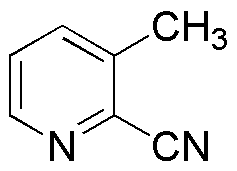2-Cyano-3-methylpyridine is widely utilized in research focused on:
- Synthesis of Pharmaceuticals: This compound serves as an important intermediate in the synthesis of various pharmaceutical agents, particularly those targeting neurological disorders.
- Agricultural Chemicals: It is used in the development of agrochemicals, including pesticides and herbicides, enhancing crop protection and yield.
- Organic Synthesis: Researchers leverage its reactivity in organic synthesis to create complex molecular structures, making it valuable in material science and chemical engineering.
- Analytical Chemistry: This compound is employed in analytical methods for detecting and quantifying nitrogen-containing compounds, aiding in environmental monitoring.
- Ligands in Coordination Chemistry: It acts as a ligand in coordination chemistry, facilitating the formation of metal complexes used in catalysis and materials development.
General Information
Properties
Safety and Regulations
Applications
2-Cyano-3-methylpyridine is widely utilized in research focused on:
- Synthesis of Pharmaceuticals: This compound serves as an important intermediate in the synthesis of various pharmaceutical agents, particularly those targeting neurological disorders.
- Agricultural Chemicals: It is used in the development of agrochemicals, including pesticides and herbicides, enhancing crop protection and yield.
- Organic Synthesis: Researchers leverage its reactivity in organic synthesis to create complex molecular structures, making it valuable in material science and chemical engineering.
- Analytical Chemistry: This compound is employed in analytical methods for detecting and quantifying nitrogen-containing compounds, aiding in environmental monitoring.
- Ligands in Coordination Chemistry: It acts as a ligand in coordination chemistry, facilitating the formation of metal complexes used in catalysis and materials development.
Documents
Safety Data Sheets (SDS)
The SDS provides comprehensive safety information on handling, storage, and disposal of the product.
Product Specification (PS)
The PS provides a comprehensive breakdown of the product’s properties, including chemical composition, physical state, purity, and storage requirements. It also details acceptable quality ranges and the product's intended applications.
Certificates of Analysis (COA)
Search for Certificates of Analysis (COA) by entering the products Lot Number. Lot and Batch Numbers can be found on a product’s label following the words ‘Lot’ or ‘Batch’.
Número de catálogo
Número de lote/lote
Certificates Of Origin (COO)
This COO confirms the country where the product was manufactured, and also details the materials and components used in it and whether it is derived from natural, synthetic, or other specific sources. This certificate may be required for customs, trade, and regulatory compliance.
Número de catálogo
Número de lote/lote
Safety Data Sheets (SDS)
The SDS provides comprehensive safety information on handling, storage, and disposal of the product.
DownloadProduct Specification (PS)
The PS provides a comprehensive breakdown of the product’s properties, including chemical composition, physical state, purity, and storage requirements. It also details acceptable quality ranges and the product's intended applications.
DownloadCertificates of Analysis (COA)
Search for Certificates of Analysis (COA) by entering the products Lot Number. Lot and Batch Numbers can be found on a product’s label following the words ‘Lot’ or ‘Batch’.
Número de catálogo
Número de lote/lote
Certificates Of Origin (COO)
This COO confirms the country where the product was manufactured, and also details the materials and components used in it and whether it is derived from natural, synthetic, or other specific sources. This certificate may be required for customs, trade, and regulatory compliance.


